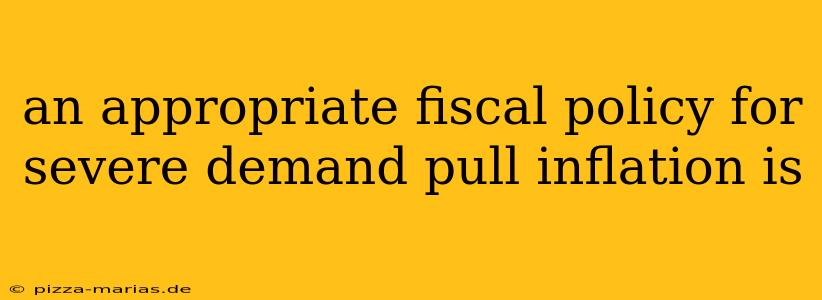Meta Description: Tackling severe demand-pull inflation requires a strong fiscal policy response. Learn about the appropriate measures, including reduced government spending, increased taxes, and the importance of coordinated monetary policy. This comprehensive guide explains how fiscal tools can curb excessive demand and stabilize the economy.
Understanding Demand-Pull Inflation
Demand-pull inflation occurs when aggregate demand in an economy outpaces aggregate supply. This excess demand bids up prices across the board. Think of it like a bidding war for limited goods and services. When demand significantly exceeds supply, prices rise sharply, leading to severe inflation. This situation necessitates a robust policy response to cool down the economy and prevent further price increases.
The Role of Fiscal Policy in Combating Inflation
Fiscal policy, controlled by the government, involves manipulating government spending and taxation to influence the economy. During periods of severe demand-pull inflation, the goal of fiscal policy is to reduce aggregate demand. This is achieved primarily through two main avenues:
1. Reducing Government Spending
Cutting government expenditure directly reduces aggregate demand. Less government spending means less money circulating in the economy, cooling down the inflationary pressures. Examples include delaying or canceling planned infrastructure projects, reducing subsidies, and cutting back on non-essential government programs. The magnitude of these cuts depends on the severity of the inflation and the overall economic situation. A gradual reduction might be preferable to sudden, drastic cuts to avoid destabilizing the economy.
2. Increasing Taxes
Raising taxes reduces disposable income for households and businesses. This decreased disposable income leads to lower consumption and investment, thus curbing aggregate demand. This can involve increasing income tax rates, sales taxes, or corporate taxes. Again, the amount of tax increases should be carefully considered to avoid negatively impacting economic growth and employment. The aim is to reduce demand, not stifle the economy entirely.
Which Taxes to Increase?
The choice of which taxes to increase is crucial. Taxes that directly impact consumption, like sales taxes or excise duties, can be effective in quickly reducing demand for goods and services. However, increasing income taxes might be less effective in the short run and could hurt consumer confidence. A balanced approach might be necessary, targeting both consumption and potentially investment through corporate tax adjustments.
Coordinating Monetary and Fiscal Policy
It's crucial to emphasize that fiscal policy is most effective when coordinated with monetary policy. Monetary policy, controlled by the central bank, involves manipulating interest rates and the money supply. When combating inflation, the central bank usually increases interest rates. Higher interest rates make borrowing more expensive, reducing investment and consumption. This coordinated approach between fiscal and monetary authorities is essential for a strong and effective response to demand-pull inflation. A misalignment, such as expansionary fiscal policy alongside contractionary monetary policy, can lead to conflicting signals and ineffective results.
Potential Challenges and Considerations
Implementing contractionary fiscal policies presents challenges. Reduced government spending can lead to lower economic growth and potentially higher unemployment in the short term. Increased taxes can also dampen consumer and business confidence, leading to decreased investment. Therefore, the government must carefully calibrate its fiscal policy response to balance inflation control with the need to maintain economic stability and minimize negative impacts on employment and economic growth. Transparency and effective communication are also crucial in managing public expectations and minimizing negative reactions.
Conclusion: A Balanced Approach is Key
An appropriate fiscal policy response to severe demand-pull inflation involves a combination of reduced government spending and increased taxes. However, the specific measures and their intensity must be carefully chosen to avoid excessive negative consequences for the economy. Coordinating these fiscal measures with contractionary monetary policy is crucial for maximum effectiveness. A balanced approach, carefully considering the potential short-term costs against the long-term benefits of price stability, is essential for navigating this challenging economic environment. The ultimate aim is to steer the economy towards a sustainable path of growth with stable prices.
